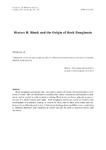Mostrar o rexistro simple do ítem
Horace R. Blank and the origin of rock doughnuts
| dc.contributor.author | Twidale, C. R. | |
| dc.date.accessioned | 2019-02-21T12:20:22Z | |
| dc.date.available | 2019-02-21T12:20:22Z | |
| dc.date.issued | 2018 | |
| dc.identifier.citation | Cadernos do Laboratorio Xeolóxico de Laxe: Revista de xeoloxía galega e do hercínico peninsular, ISSN 0213-4497, Nº 39, 2017, páxs. 187-214 | es_ES |
| dc.identifier.issn | 0213-4497 | |
| dc.identifier.uri | http://hdl.handle.net/2183/21909 | |
| dc.description.abstract | [Abstract] Rock doughnuts are annular rims developed around rock basins that intermittently carry pools of water. They are developed in granitic rocks, and in arenaceous and calcareous sediments and in coastal as wells as interior settings. Rock levees are found adjacent to gutters but are of a similar nature and origin. Both doughnuts and levees can be attributed to the development of protective coatings or veneers by biota, and of silica, iron oxides, and carbonates by overflowing pool waters. Contrasts in drainage from regolithic covers, weathering at sheltered interfaces and variations in runoff can also be cited at causative factors and situations. | es_ES |
| dc.language.iso | eng | es_ES |
| dc.title | Horace R. Blank and the origin of rock doughnuts | es_ES |
| dc.type | info:eu-repo/semantics/article | es_ES |
| dc.rights.access | info:eu-repo/semantics/openAccess | es_ES |
| UDC.journalTitle | Cadernos do Laboratorio Xeolóxico de Laxe: Revista de xeoloxía galega e do hercínico peninsular | es_ES |
| UDC.volume | 40 | es_ES |
| UDC.startPage | 187 | es_ES |
| UDC.endPage | 214 | es_ES |






